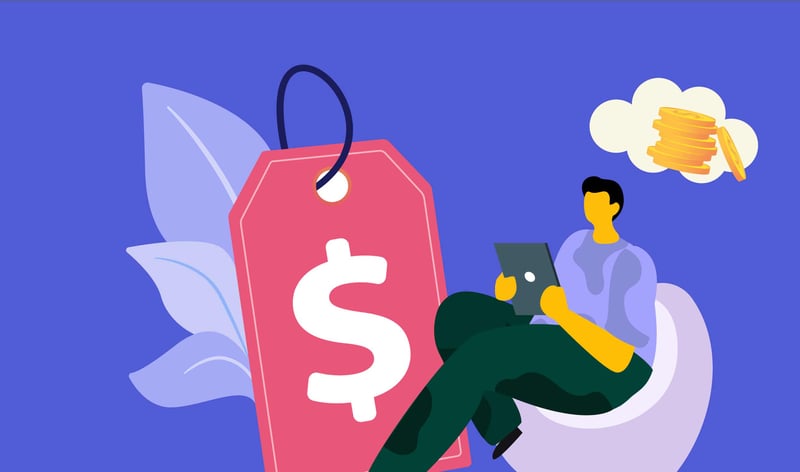As a reseller, pricing is a science. You want to price low enough that you entice prospective buyers, but high enough to account for your cost of goods, platform fees, and entertaining offers. Here is a guide to how I price my items for sale on Poshmark, eBay, Mercari, Depop, and others!
1. Comp Research
“Comps” or Comparables refer to comparable pricing on similar items; that is determining what your item is selling for as well as what it has sold for. Comp research can be done on most platforms by searching listings and filtering the brand and categories to generate results that are identical (or at least similar) to your item. Of course, you can filter by condition or “available” and “sold” as well.
How to Do Comp Research:
Below, to find the sold comps on a pair of Lululemon shorts on Poshmark, I searched for “Lululemon Shorts”, and filtered by “Just Shared”, “Shorts”, “Lululemon”, “All Sizes”, “Yellow”, and “Sold.” Because Lululemon is a very popular brand, I was able to find many comps for the exact pair I want to list. I found that sold comps are in the $30-$50 range.

Below, to check the active comps on the same pair of shorts, the search is identical except for that I filter by “active listings.” Here, I am able to see that active prices are in the $60-$90 range.

This process works similarly on most reselling platforms. Now that I have an idea of the average asking price and average sale price for my item, I will consider those values when I determine the price.
2. Analyzing Comps
Which matters more- Active listings or sold listings- when it comes to researching comps and pricing? It depends who you ask.
Some resellers emphasize the pricing on active listings, and others focus on sold listings. Some resellers focus on available items, browsing their immediate competition in comparable active listings. Other resellers focus on the sold listings to gain a reasonable idea of what the item might actually sell for. I recommend peeking at both. The active listings are your immediate competition, but the sold ones may provide you with insight as to what might constitute a reasonable offer or fair sale price.
My pricing is more influenced by active listings, because the sold ones are gone and unavailable to my buyer. Alternatively, the active listings are my immediate competition that may also be viewed by a buyer considering my item.
There are many things that may distort the value of sold comps such as trades, bundle purchases or seller discounts, trends and popularity, or the unknowing seller who sold their item for way too low or way too high. I honestly “ruin” my comps all the time when I source from the resale platforms to flip for a profit!
Further, comps and values of items may fluctuate. Trends play a large part in the pricing market. Six years ago, Lularoe was a top-selling brand, and today it is widely regarded as a nightmare brand that resellers can hardly give away. Alternatively, Squishmallow stuffed animals are hot sellers right now, but they likely won’t be next summer. Style trends are very influential in the market. Comps fluctuate based upon time and demand as well. Vintage items, Deadstock items (which are no longer in production), limited edition items, and rare items may have a higher value than comps might suggest. The value of an item is entirely subjective; your item is worth what someone will pay for it. Some vintage pieces can sell for over ten times their original retail value!
You may also like: 9 Steps to Start a Reselling Business Online for Profit
3. Establishing a Pricing Model
My pricing model has changed quite a bit over the years. Here are three different strategies I have used:
a). As a newer seller, I significantly undercut comps to make for quick sales. This model works, because quick sales keep the profit flowing.
b). Once I had my selling platforms more established, I raised my prices to be more consistent with comps, utilizing the best images and listing descriptions I could. With good photos, descriptive listings, and frequent activity, this model can be very successful.
c). Today, I generally price much higher than comps. I strive to draft amazing listings with the maximum number of images (and videos), amazing cover photos, and descriptions which truly maximize SEO. I have done quite a bit of research on SEO and keywording, which is the key to sales and increasing profit. In theory, if your description is full of SEO keywords and search terms, then it doesn’t matter if you price higher than all of the other listings, because your listing is the one that will show up as a result of a buyer’s search. When you maximize SEO, combined with amazing photographs, frequent activity and listing management, you can exceed comps and still generate frequent sales. See below:
Listing A
Listing B
Compare Listing A (Price $95) and Listing B (Price $45). Despite the price difference, Listing A will probably sell before Listing B, and for a higher value. All of the detail provided in Listing A will make it appear in so many more searches, yielding greater exposure, activity, likes, and offers. SEO has to be part of your pricing model. If you are willing to put in the work, you can charge more for your items.
You May Also be Interested in How to Create Product Listings That Sell on eBay and Poshmark
4. Other Pricing Considerations
There are so many other factors to consider in your pricing model. Do not forget to account for your cost of goods (COGS), time and business costs, platform fees, shipping costs, and taxes if applicable.
Most importantly, try to price a little higher to account for offers, engaging in negotiation, shipping discounts, sales and promotions. I usually price my items 30% higher than I actually want to sell them for!
Reseller Tip: Have a unique or vintage item that you just can’t find any information about? No idea how to price? Don’t be afraid to price it high. If you don’t price it high, you can’t sell it outright to the right buyer. You can always entertain offers and gradually decrease, relist, or amend your listing if there is no activity.
5. Scaling to Increase Profit
This is something that it has taken me years to learn, and I am still stuck with some inventory that I am upside down on in consideration of the time it took to list, and the time I spend daily relisting, responding to questions and offers, and managing my listings across multiple platforms. It has taken me time to truly appreciate that time is money, and my time is valuable. Even if something is free, does not mean that it is worth selling when you consider your time.
I have amended my sourcing model to seek items that can yield at least a twenty-five-dollar profit, after costs and fees. Even if that means less packages are going out, more money is coming in.
That being said, I have also become less romantic about comps and an item’s subjective “value”. If I purchase an item for under $1, and comps suggest pricing around $60, I will price around $80, but I will also accept any offer over $40. (That’s right, I invite low offers, because my COG is low). I price high, but that does not always mean that I sell high. I sell my items for whatever yields a comfortable return on investment (ROI) under my personal business model. I would rather turn over items quickly than hold onto items, continuing to devote time and money to maintaining my inventory, to maybe yield a higher sale price.
These factors will be weighted differently for everyone, their business model, storage, sourcing options, type of inventory, and re-selling platform. What are your best pricing tips? Share them below!






